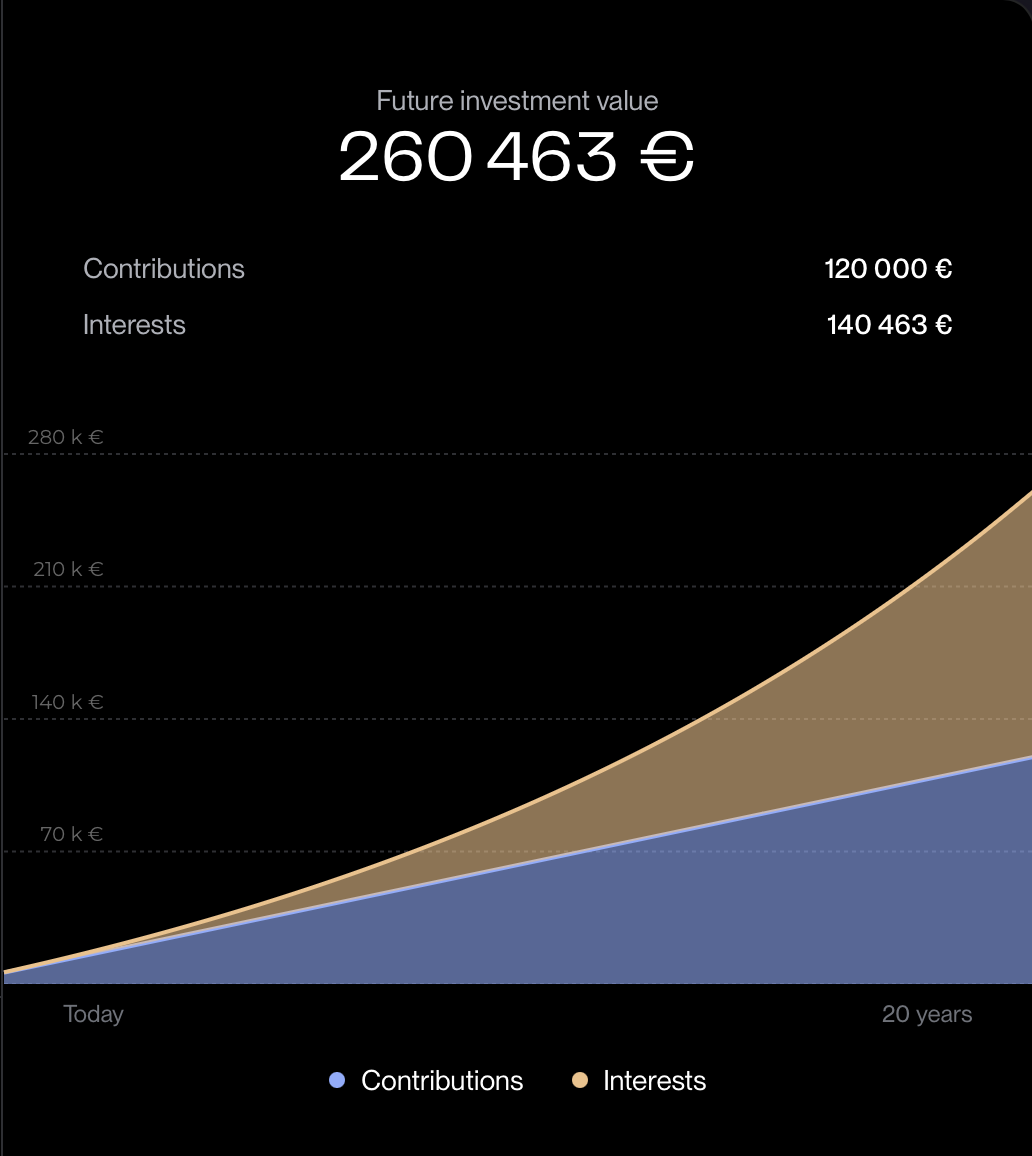
Compound Interest Calculator: How €50, €100, €500, or €1000 per Month Grows Over Time?
Discover compound interest explained with real tables—€50, €100, €500, and €1000 per month—plus formulas, calculators, and practical tips.

Albert Einstein reportedly called compound interest the “eighth wonder of the world.” When you see compound interest explained in action with a compound interest calculator, it becomes clear why: small sums can snowball into surprisingly large totals.
In this guide, we’ll walk through compound interest examples with real numbers—€50, €100, €500, and €1000 per month—so you can see how your money might grow over time.
1.
What is compound interest and how does it work?
Compound interest is interest earned on both your original money and on the interest that has already been credited. This “interest-on-interest” effect is what accelerates growth, even with small, regular contributions (SEC, Investor.gov 2025). Put simply: invest regularly, earn returns, then let those returns earn more.
What is the difference between simple interest and compound interest?
- Simple interest: only the original deposit earns interest. Example: €1,000 at 5% simple interest for 3 years earns €150 total, ending with €1,150.
- Compound interest: both the original deposit and past interest earn. The same €1,000 at 5% compounded annually grows to €1,157.63 after 3 years (CFPB, ConsumerFinance.gov 2023).
How is the compound interest formula calculated?
The compound interest formula for a lump sum is:

A = P × (1 + r/n)^(n×t)
- P = principal (starting balance)
- r = annual interest rate (decimal)
- n = number of compounding periods per year
- t = years
- A = future amount
For monthly investment compound interest, calculators use the future value of a series formula:

FV = PMT × [((1 + i)^N − 1) / i]
Where PMT = monthly payment, i = r/12, and N = 12×t (SEC, Investor.gov Compound Interest Calculator 2025).
2.
Real-life examples with monthly investments
Assumptions: monthly contributions at month-end, annual rates of 4% and 7%, monthly compounding, no fees or taxes. Actual results vary; fees and taxes reduce returns (SEC, Mutual Fund and ETF Fees Bulletin 2025; HMRC, Savings Tax Guide 2025).
How much does €50 per month grow with compound interest?
How much does €100 per month grow with compound interest?
How much does €500 per month grow with compound interest?

How much does €1000 per month grow with compound interest?
3.
Why calculators matter and how to use them?
How can a compound interest calculator help you plan your investments?
A compound interest calculator lets you adjust timeframes, monthly inputs, and rates. Beginners can see how small contributions add up and understand the trade-off between starting now versus later (FINRA, 5 Steps to Take Control of Your Finances 2024).
Why should you use real numbers (€50–€1000) as examples?
Because planning with actual budgets shows how achievable compounding is. Even modest amounts illustrate how growth accelerates the longer you stay invested (CFPB, ConsumerFinance.gov 2023).
How do different interest rates change the final result?
Changing from 4% to 7% nearly doubles 30-year outcomes in our tables. But higher expected returns come with higher risks, so always test a range (SEC, Investor.gov 2025).
Now you understand well how compound interest work, you should try a real time simulator like this one: Compound Interest Calculator.
4.
Practical tips for maximizing compound interest
What are the best tips to make the most of compound interest?
- Automate monthly transfers so you never skip a contribution (SEC).
- Minimize fees, which can erode compounding (SEC Bulletin).
- Use tax-efficient accounts where available, like ISAs or pensions (HMRC).
- Increase contributions as your income rises (FINRA).
How does time impact compound interest growth?
The earlier you start, the more “cycles” of compounding you benefit from. Ten extra years can outweigh bigger deposits made later (CFPB).
Why does starting early matter more than investing more?
Because your returns also generate returns. Early investing multiplies growth more effectively than waiting to invest larger amounts (SEC).

5.
Conclusion
Compound interest rewards time, patience, and consistency. Whether you invest €50 or €1000 per month, the real growth comes from letting your money work on itself. Use a compound interest calculator, choose realistic rates, and give compounding time to do its work (SEC).
6.
7.
8.
Frequently Asked Questions
What rate should I use in a compound interest calculator?
Try 4%–7% for a balanced view; higher rates mean more growth but also more risk (FINRA).
How often should interest be compounded?
Monthly is common in calculators; more frequent compounding gives a slight boost but contributions matter more (SEC).
Does compound interest also apply to debts?
Yes, debts can compound too—making them grow faster if unpaid (CFPB).
Should I factor in fees and taxes?
Yes, both reduce returns significantly; always check account charges and tax rules (HMRC; SEC).
Is 7% growth realistic?
Historically possible but never guaranteed; test conservative and moderate rates (SEC; FINRA).
Risk Disclosure
SEC, Investor.gov Compound Interest 2025 ; SEC, Compound Interest Calculator 2025 ; SEC, Mutual Fund and ETF Fees Bulletin Jul 23, 2025 ; SEC, Saving and Investing Guide PDF Feb 2019 ; CFPB, How Does Compound Interest Work? Nov 7, 2023 ; FINRA, 5 Steps to Take Control of Your Finances Jan 9, 2024 ; FINRA, Financial Education PDF Jun 2025 ; HMRC, Savings Tax Guide Mar 3, 2025 ; HMRC, Personal Savings Allowance Dec 9, 2015.









